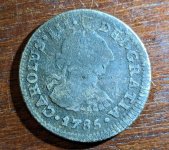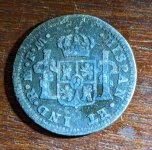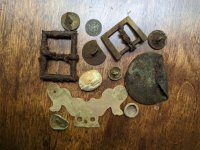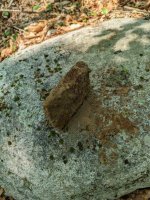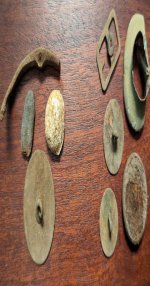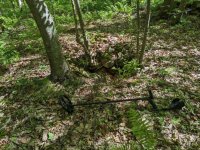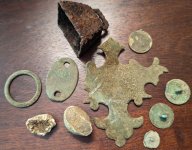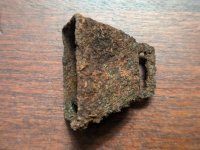You are using an out of date browser. It may not display this or other websites correctly.
You should upgrade or use an alternative browser.
You should upgrade or use an alternative browser.
1785 Sliver
- Thread starter OxShoeDrew
- Start date
Tony Two-Cent
Administrator
Wow! Very nice, Drew! Way to rescue that great coin. Is it a half real or one real?
I hope it is a cabin sit and that you unearth more treasures there!
:congrats:
I hope it is a cabin sit and that you unearth more treasures there!
:congrats:
del
Administrator
Congrats Drew , still with .71 or the new update?
Its a half real Tony the lone "R" is for "reale" or half , any other would have a numeral before the "R" to designate denomination
Is it a half real or one real?
Its a half real Tony the lone "R" is for "reale" or half , any other would have a numeral before the "R" to designate denomination
OxShoeDrew
Administrator
Thanks, guys! Still .71 Dan, I thought I had the small headphone update cord but I don't, so I have to order one tomorrow.
OxShoeDrew
Administrator
:lol: Thanks, Roger...my wife said the same thing. I love how off center the strike is.WTG Drew, you're on a roll. Look at the schnozz on him, lol!
OxShoeDrew
Administrator
Thanks, Jared!
I went back today and I'm convinced its a cabin site. Pictured was found within a ten yard radius around where I think the cabin was. Colonial drawer pull plate (Queen Ann?), couple of buckles (one looks newer but I don't know), two ox shoes, completely round piece of copper (bigger than a rosette), many old nails including floor nails are not pictured but all rose head, 1785 coin, hand full period buttons, and an ax head (date?)
1-It's the highest point in the surrounding area
2-There are a few cairns in the immediate area
3-a small enclosed pen around the cabin can be seen but is almost entirely buried
This is the second cabin I've found. Like the first one finds are not plentiful. In the other one I only found a French Rev War button (95) and a CT copper. Thanks for looking!
I went back today and I'm convinced its a cabin site. Pictured was found within a ten yard radius around where I think the cabin was. Colonial drawer pull plate (Queen Ann?), couple of buckles (one looks newer but I don't know), two ox shoes, completely round piece of copper (bigger than a rosette), many old nails including floor nails are not pictured but all rose head, 1785 coin, hand full period buttons, and an ax head (date?)
1-It's the highest point in the surrounding area
2-There are a few cairns in the immediate area
3-a small enclosed pen around the cabin can be seen but is almost entirely buried
This is the second cabin I've found. Like the first one finds are not plentiful. In the other one I only found a French Rev War button (95) and a CT copper. Thanks for looking!
Attachments
Lodge Scent
New member
Nice one Drew! Yeah at this point you might as well wait for V1.01 to come out before you update.
Digger_O'Dell
New member
Those are some great finds, and that Reale is in great shape! Certainly didn't see a lot of circulation before it was lost. Congrats!
OxShoeDrew
Administrator
Thanks Jeff and Chris! I went back today and noticed more buried walls and more cairns surrounding the cabin site. The stuff on the left was around the cabin and on the right is from the later cellar hole lip. I called our dealer, Jeff to order the headphone update cord but they sold the business! New people don't answer the phone. I emailed and got a form reply that they're working on it. So I'm still v.71...I feel so plebeian :lol:. Did you know they sold?
Edit-:lol:. I don't know what happened to that picture!
Edit-:lol:. I don't know what happened to that picture!
Attachments
wisconsin digger
New member
Congrats on the great recovery. The post made me laugh as I found a Rosie yesterday and I was happy to find a silver finally in May and then I look at this coin that is 162 years older than the coin I found. WOW what a contrast. Different pleasures for different people. Thx for posting. PS I am always amazed at the great history you have. WD
Digger_O'Dell
New member
Congrats on the great recovery. The post made me laugh as I found a Rosie yesterday and I was happy to find a silver finally in May and then I look at this coin that is 162 years older than the coin I found. WOW what a contrast. Different pleasures for different people. Thx for posting. PS I am always amazed at the great history you have. WD
I know your pain! I only found 1 silver in the past 2 year! Of course it's that beautiful 1877 seated dime, but not sure if I want to wait another 2 years for another silver. Yet, compared to that Reale, I'm certainly jealous!
OxShoeDrew
Administrator
Thanks, fellas... I'm in the best place in the US. People came here in the 1600s, started leaving before the CW, kept leaving until after WW2. Never rebuilt on these sites.
I went back to this cabin site and found a stone-lined well 100yrds away and some more buried walls. The 1920 wheat and tiny cow bell (goat bell?) was found near the more recent cellar hole. Everything else was near the cabin.
I went back to this cabin site and found a stone-lined well 100yrds away and some more buried walls. The 1920 wheat and tiny cow bell (goat bell?) was found near the more recent cellar hole. Everything else was near the cabin.
Attachments
del
Administrator
Thanks, fellas... I'm in the best place in the US. People came here in the 1600s, started leaving before the CW, kept leaving until after WW2. Never rebuilt on these sites.
I went back to this cabin site and found a stone-lined well 100yrds away and some more buried walls. The 1920 wheat and tiny cow bell (goat bell?) was found near the more recent cellar hole. Everything else was near the cabin.
wells usually weren't a 100 yards away from the house (unless the home was on very high ground and they didn't want to dig a very deep one) so you either have the real location of the cabin or this well is close to the barn or you have another cabin site altogether , Drew.
Dan
Digger_O'Dell
New member
Thanks, fellas... I'm in the best place in the US. People came here in the 1600s, started leaving before the CW, kept leaving until after WW2. Never rebuilt on these sites.
I went back to this cabin site and found a stone-lined well 100yrds away and some more buried walls. The 1920 wheat and tiny cow bell (goat bell?) was found near the more recent cellar hole. Everything else was near the cabin.
More great finds! You're lucky to have sites like this. I have only run across one such site in my area, having a cellar hole lined with field stone and a stone lined well. Absolutely no finds in the area...go figure.
OxShoeDrew
Administrator
Chris, we have some cellar holes that are very quiet. I always thought it had to do with the age of the hole, like very early ones have less coins because there was no on else around to trade with.
Dan, this well is the same elevation of where I think the cabin is. Also, there is an opening in a wall associated with the newer hole right in front of the well, the opening is between the well and the newer cellar hole. Maybe it a second well for horses for the newer hole? The well, cabin, and newer hole make a triangle where the distances are well-cabin .08 mi (422ft), well-new hole .1mi (528 ft). I checked all around the well and didn't hear any metal but I'll go back today and recheck. The new hole still has it's own well next to it which looks like it got a stone-lined-in-concrete upgrade in the 20s or 30s.
Let me know if you want to check out the site sometime.
Dan, this well is the same elevation of where I think the cabin is. Also, there is an opening in a wall associated with the newer hole right in front of the well, the opening is between the well and the newer cellar hole. Maybe it a second well for horses for the newer hole? The well, cabin, and newer hole make a triangle where the distances are well-cabin .08 mi (422ft), well-new hole .1mi (528 ft). I checked all around the well and didn't hear any metal but I'll go back today and recheck. The new hole still has it's own well next to it which looks like it got a stone-lined-in-concrete upgrade in the 20s or 30s.
Let me know if you want to check out the site sometime.
del
Administrator
Drew , I would be interested to check it out . Wells were always near a barn or outbuilding or a homesite , I've seen some homes have a well near their home on a knoll or hill and then have another well down the hill near a run off because in the hot summer time the well on the hill might go dry but the lower one near a water run off would still be pretty full .
Digger_O'Dell
New member
Chris, we have some cellar holes that are very quiet. I always thought it had to do with the age of the hole, like very early ones have less coins because there was no on else around to trade with.
Drew,
Thanks for the insight, I hadn't thought of that scenario. In a field not too far away, maybe 1/2 mile or so the old maps showed structures there during the 1870s, and I even pulled my only fatty IH find from there-but the finds were also pretty few and far between mostly later IHs and a crotal bell to name a few. But I suspect the cellar hole is probably far earlier than the field site and was likely abandoned before many people arrived. Records state the area was first settled around the 1850s, but there's also some mention of a lot of traders, trappers and explorers (missionaries?) that spent time in the area, possibly trading with the natives, as far back as the late 1600s or early 1700s.
As a side note, the first European to set foot in Wisconsin is attributed to French explorer Jean Nicolet who arrived in 1634. Another unnamed French Jesuit explorer set up a stone altar and raised a cross dedicated to Mary atop a nearby peak in 1676, only about 15 miles from where my cellar hole is located, and likely in line with a route people would traverse between that point and and Lake Michigan.
del
Administrator
Drew,
Thanks for the insight, I hadn't thought of that scenario. In a field not too far away, maybe 1/2 mile or so the old maps showed structures there during the 1870s, and I even pulled my only fatty IH find from there-but the finds were also pretty few and far between mostly later IHs and a crotal bell to name a few. But I suspect the cellar hole is probably far earlier than the field site and was likely abandoned before many people arrived. Records state the area was first settled around the 1850s, but there's also some mention of a lot of traders, trappers and explorers (missionaries?) that spent time in the area, possibly trading with the natives, as far back as the late 1600s or early 1700s.
As a side note, the first European to set foot in Wisconsin is attributed to French explorer Jean Nicolet who arrived in 1634. Another unnamed French Jesuit explorer set up a stone altar and raised a cross dedicated to Mary atop a nearby peak in1676, only about 15 miles from where my cellar hole is located, and likely in line with a route people would traverse between that point and and Lake Michigan.
take pictures next time your there or anywhere really you think some very old areas are or suppose to be , we might be able to spot something that is a bit subtle to what your use to .
